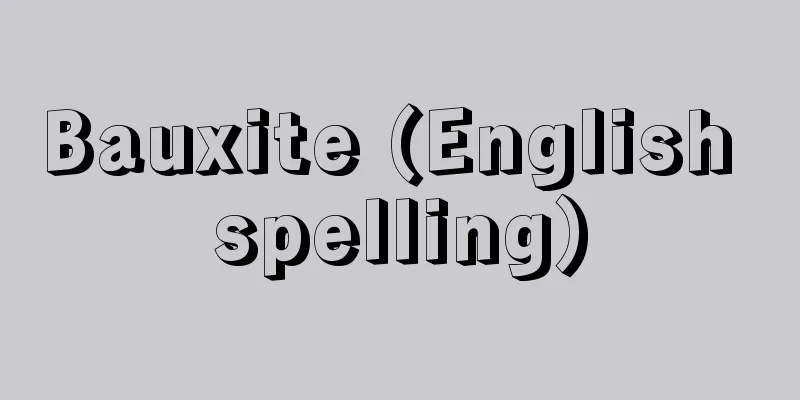Class - Kaikyu (English spelling) class English

|
Generally speaking, class refers to a group of people who enjoy roughly equal amounts of power and who stand in asymmetrical relationships within society, such as hierarchical, superior, inferior, rich and poor, ruling and being ruled, exploiting and being exploited, based on the unequal distribution of social resources or power (wealth, power, prestige, etc.). In the broad sense, class is a higher concept that includes caste (family name) and social status as closed classes, and modern class as open classes, but in the narrow sense class often refers to modern class. In this respect, class is distinguished from hierarchical classes in general. Class is not only an important factor that determines the nature of social structure and determines social change at the root of social order, but also permeates all aspects of human life, determining people's life opportunities, influencing human happiness and unhappiness, the joys, anger, sorrows, and happiness of life, and imposing stigma on thoughts, emotions, and actions. [Akira Hamashima] The formation of the concept of classFor these reasons, class phenomena have attracted people's interest and become a subject of study from an early stage. Ancient Greek state philosophy recognized political struggle as a struggle between social classes and discussed the issue of adjusting the power relationships between these classes, and Aristotle considered the class structure of society to be a natural order based on differences in people's individual qualities. In medieval scholastic philosophy, class was considered to be a natural order derived from the economic division of labor. However, the idea of class as a natural order does not yet deserve to be called a scientific understanding. In the 18th century British empirical social theory, classes were considered to be the result of the acquisition of wealth through labor and to involve differences in power. Classes were considered to arise from differences in the type and amount of property, and property relations were considered to be determined by the nature of the economic system. Ferguson and A. Smith considered the relationship of dominance and subordination between classes to be derived solely from unequal distribution of property. On the other hand, Marat, based on his experience with the French Revolution, recognized class struggle in the revolution and realistically understood political change as a struggle between classes. However, since industry was still underdeveloped at that time, no truly scientific consideration of classes was produced. For example, in the case of Saint-Simon, the conflict of interests between the new classes and the aristocracy and clergy, who represented the old system, was considered self-evident, but because he believed that the interests of capitalists and workers were fundamentally solidary, both were lumped together under the industrial class. However, in terms of outlook for the transition from the feudal system of land-owning aristocrats to the industrial system of entrepreneurs, Saint-Simon's view represented a step forward. Stein, who studied the class struggle in France as a social movement, also believed that the principles of society, which are determined by the distribution of wealth and the organization of labor and which cause the domination of the propertyless by the propertied, would permeate the state, causing the state to turn into a class state for the ruling class and to suppress freedom, and thus giving rise to social movements as movements for freedom. However, because Stein expected the realization of freedom to come from social policies from above rather than from social movements from below, he did not go so far as to scientifically explain class struggle. It was none other than Marx who achieved the feat of elucidating the true meaning of class phenomena from the structure and laws of motion of the capitalist system and establishing a scientific theory of class. [Akira Hamashima] Marxist Class TheoryMarxism inherited and further developed the British empirical social theory (A. Smith, etc.), the French utopian socialism (Fourier, Saint-Simon, etc.), and the German idealist philosophy (especially Hegelian dialectics). The ultimate goal of Marx's class theory was to clarify the laws of motion in modern capitalist society through classes and class struggle, and to demonstrate the inevitability of revolution. As Marx himself stated, it was not his achievement to discover the existence of classes in modern society or the struggle between classes, but rather, it is distinctive in that he linked the existence of classes to a specific stage of the historical development of production, and argued that class struggle inevitably brings about the dictatorship of the proletariat, and that this dictatorship is merely a transitional stage leading to the abolition of classes and the arrival of a classless society. It was with this intention and perspective that the explanatory diagram (the two great classes model) was presented, which is centered on the opposing and conflicting classes of capital and wage labor. According to this two great classes model, the emergence of classes is based on the establishment of private ownership of the means of production accompanying the development of private productive forces (development of the division of labor), and the resulting appropriation of the labor of others through the division of labor and ownership. Examples of this are the class relations between slave owners and slaves in ancient times, lords and serfs in the Middle Ages, and capitalists and workers in modern times, the relationship of domination and exploitation of the latter by the former. In this case, the crucial issue is whether or not one owns the means of production, and the resulting difference in status in the relations of production. It is the ownership or non-ownership of the means of production that determines the amount of economic power enjoyed and determines the dominant and subordinate status and role in the relations of production. From this, heterogeneous and antagonistic classes are formed that stand in the relationship of exploiter/exploited (unequal distribution of wealth) and dominator/dominated (unequal distribution of power). Inequality in production relations gives rise to inequality in distribution relations, which in turn leads to significant and perpetuated discrimination in rights, interests and opportunities in all aspects of life. According to Lenin, the classes thus created are "great masses of men who differ in their status in the specific social relations of production in history, in their relationship to the means of production (which are for the most part established and formalized by law), in their role in the organization of social labor, and therefore in the way and amount of their share of social wealth," and because of these differences in status, the relationship between classes is inevitably one of exploitation and exploitation, domination and domination, "where one can monopolize the labor of the other" (Great Ingenuity, 1919). Moreover, since differences in the base are accompanied by differences in the superstructure, the economically dominant class is also the politically, socially, and culturally dominant class. In other words, the class that can control the means of material production can also control the means of spiritual production, so that in every era the ideology of the ruling class becomes the dominant ideology and dominates the dominated class ideologically as well. Now, a class in the systemically defined sense of capital versus wage labor represents a state of discrimination accompanied by an objective conflict of interests, but in itself it is not a class with a keen awareness of its own class status or class interests, but merely constitutes a class in the sense of wage labor versus capital. Marx called this kind of class a "class in itself" (Klasse an sich) and distinguished it from a class that has reached a higher level of self-awareness (Klasse für sich). He said that a truly self-aware class (class in itself) is only established when a class is conscious of its common interests (conflict of interests against others) and has united under an organization to engage in class struggle. The development from a class in itself to a class for itself follows the course of class discrimination → class interests → class conflict → class struggle, and it is argued that this process is not only a process of raising class consciousness but also a process of class organization, and that under conditions such as the formation of national commodity and labor markets due to the development of capitalism, the concentration of large numbers of workers in industrial areas, the breaking down of regional closedness (isolation and dispersion), the collapse of the skill-based hierarchical order and the fixation of wage labor relations due to the advancement of division of labor and mechanization, and the leadership of intellectuals, class unity is realized through the formation of labor unions and political parties, and movements aimed at changing the system (class struggle) also intensify. Moreover, Marx predicted that in capitalist society, due to the action of the laws inherent in it, the polar division into two major classes, labor and capital, will become stronger in the future, the condition of workers will worsen and they will become more and more impoverished, class consciousness and class struggle will become more and more acute, and eventually lead to a social revolution. In other words, the basic line of Marxist class theory is that the development of capitalism itself intensifies internal contradictions, which will cause solidarity and unified action among workers who are exploited, dominated, and tied to inhuman conditions, encouraging the rise of class consciousness and class struggle and opening the way to revolution, but the scientific evidence for this is the division of society into two major classes, labor and capital (polar division theory), the further deterioration of the condition of workers (impoverishment theory), and the inevitability of a major economic catastrophe (crisis theory). Therefore, the effectiveness of Marx's prediction depends on whether these arguments are applicable to modern society as they are. [Akira Hamashima] Modern Society and ClassIn modern developed countries, with the rapid development of technology and the expansion of production mechanisms, especially in the face of the accumulation and concentration of capital, the shadow of the free entrepreneur fades and managers replace the capitalists, while the farmers, especially of the self-employed agricultural, industrial and commercial classes that made up the old middle class, break up and, coupled with the conversion of family employees within the self-employed classes into wage labor, the number of employed workers has increased rapidly. However, the increase in employed workers has not necessarily led to an increase in productive workers, but has instead caused an expansion of those in specialized technology, clerical work, sales and service-related fields (the so-called new middle class = white collar). Some people say that Marx's prediction of the polar decomposition into two major classes of labor and capital has been betrayed by the slowdown in the growth rate of the number of productive workers (relative decrease) and the expansion of the new middle class, although this may be the case for some of the self-employed classes such as farmers (including family workers). For example, M. Weber even goes so far as to deny the tendency toward a unilateral proletarianization, citing the increase in the number of employees due to the progress of bureaucratization. Of course, this is an extreme view, and it can be interpreted that the differences in the quality of work and treatment that distinguish blue-collar and white-collar workers have almost disappeared, and the proletarianization of the lower classes of white-collar workers is actually progressing. On the other hand, as for the impoverishment (imprisonment) predicted by Marx, under the high economic growth supported by the rapid increase in productivity, the spread of durable consumer goods and the improvement of living standards have standardized lifestyles and attitudes, so that classical poverty seems to have disappeared. Of course, modern poverty is characterized by the coexistence of poverty and the possession of durable consumer goods, so it would be hasty to conclude that impoverishment has been completely eradicated in a wealthy society supported by high levels of mass consumption. Today's economic trends, which have shifted from high growth to low growth, are full of reasons for pessimism, such as recession, unemployment, bankruptcies, and increased hardship, but the risk of the automatic collapse of the capitalist economy due to the cyclical recurrence of depressions has been prevented by the development and expansion of national economic policies. Therefore, we are unlikely to expect a major catastrophe due to depression. Thus, the apparent expansion (deproletarianization), leveling and enrichment of the new middle class has led to the spread of a petty-bourgeois attitude to life among a wide range of employed workers, the tendency to seek comfort in private life works in the direction of conformity to the system rather than reform, and the new form of labor-management relations which institutionalizes class conflict serves to strengthen class peace and incorporation into the system rather than intensifying class struggle and class consciousness. How to interpret trends in classes, class consciousness and class struggle in such modern society has become an important issue in class theory. [Akira Hamashima] Class and hierarchy issues in a socialist societyThe class situation seen in advanced capitalist societies is the result of huge social changes brought about by technological innovation and the consumer revolution, but it can be said that what strongly determines the modern class and stratification problem is the sophistication of technology and the corresponding bureaucratization of organizations. The expansion and sophistication of technology and organizations has caused a separation of ownership and management, and has created a class of people who are responsible for management and operation based on their practical knowledge (executives, managers, technical bureaucrats, etc.). In the process of technology and organizations becoming more advanced and larger (= bureaucratization), organization (institutional authority justified by organization) has become the basis of class rule instead of ownership, promoting the rule of managers and technocrats. From the perspective of industrialism and convergence theory, it is argued that where such logic of technology and organization runs through, hierarchical differentiation between those who manage and those who are managed is inevitable regardless of the system, and classes and nations will not die out but will become increasingly powerful. According to the doctrinal system of Marxism-Leninism, if private ownership of the means of production was abolished and transferred to social ownership and placed under the control of the entire people, then classes and class rule would be completely abolished during the transitional period of the dictatorship of the proletariat. However, in the Soviet-style socialism before its collapse, under the economic and political system based on social ownership and the dictatorship of the proletariat, a huge class of managers, organizers, and technicians (what M. Djilas calls the "new class") emerged to manage the economy and politics, causing significant inequality in terms of wealth, power, and privileges, and classless society was in name only. The relatively small number of privileged people who made up this new class were also called nomenklatura (in Russian), and managed and controlled the socialist state under the name of the dictatorship of the proletariat and one-party dictatorship. In any case, in modern highly developed industrial societies, regardless of the difference between capitalist and socialist systems, class rule by a small elite seems to be an inevitable fate due to the need to manage and operate huge technologies and organizations. [Akira Hamashima] "The New Classes: An Analysis of the Communist System" by M. Djilas, translated by Genbayashi Jiro (1957, Jiji Press)" ▽ "The Great Invention" translated by the Committee for Publication of the Collected Works of Lenin (included in The Collected Works of Lenin vol. 29, 1958, Otsuki Shoten)" ▽ "The Communist Manifesto" (included in The Collected Works of Marx and Engels vol. 4, 1960, Otsuki Shoten/Iwanami Bunko/Otsuki Shoten/Kokumin Bunko)" ▽ "Classes and Class Struggle in Industrial Society" by R. Dahrendorf, translated and supervised by Tominaga Kenichi (1964, Diamond Inc.)" ▽ "Das Kapital" (included in The Collected Works of Marx and Engels vol. 23-25, 1965-67, Otsuki Shoten/Iwanami Bunko/Otsuki Shoten/Kokumin Bunko)" ▽ "The Class Structure of Advanced Societies" by A. Giddens, translated by Ichikawa Munehiro (1977, Misuzu Shobo)" ▽ "Socialism" by M. Weber, translated by Akira Hamashima (1980, Kodansha)" ▽ "Nomenklatura" by M.S. Voslensky, translated by Mutsuo Sakuma and Mitsuyuki Funato (1981, Chuokoron-Shinsha)" ▽ "Class Structure of Japan" edited by Takanori Ohashi (Iwanami Shinsho)" [References] | | | | | |Source: Shogakukan Encyclopedia Nipponica About Encyclopedia Nipponica Information | Legend |
|
一般に、全体社会の内部において社会的資源または勢力(富力、権力、威信など)の不平等な配分に基づいて成立する上下・優劣、貧富、支配・被支配、搾取・被搾取などといった非対称的な関係にたち、ほぼ同等の勢力量を享有する人々の集群をいう。広い意味での階級は、閉鎖的階級としてのカースト(種姓)や身分と、開放的階級としての近代階級を含む上位概念であるが、狭い意味での階級は近代階級をさすことが多い。その点で、階級は階層一般とは区別される。階級は社会秩序の根底にあって社会構造の性格を決め、社会変動を規定する重要な要因であるばかりか、人間生活の全局面に浸透して人々の生活機会を決定し、人間の幸・不幸、人生の喜怒哀楽を左右し、思想、感情、行動に烙印(らくいん)を押し付ける働きをする。 [濱嶋 朗] 階級概念の形成このような事情から、階級現象は早くから人々の関心をひき、考察の対象となってきた。古代ギリシアの国家哲学では、政治闘争を身分層間の闘争と認め、これらの層の勢力関係の調整問題を論じていたし、アリストテレスは、社会の階級別編成を人々の個人的素質の違いに基づく自然的秩序だと考えた。中世のスコラ哲学では、階級は経済的分業に由来する自然的秩序だとみなされていた。しかし、階級を自然的秩序とみなす考えはまだ科学的認識の名に値しない。 下って18世紀イギリスの経験的社会論では、階級は労働による富の獲得の結果であり、権力の差を伴うものとされた。階級は財産の種類と量の違いから生まれるもので、財産関係は経済体制のあり方に規定されていると考えられた。ファーガソンやA・スミスらは、階級間の支配従属関係をもっぱら財産の分配の不平等に由来するとみたのである。他方、マラーはフランス革命の経験から、革命のなかに階級闘争を認め、政治変革を階級間の闘争として現実的に把握していた。しかし、当時はなお産業が未発達であったため、階級についての真に科学的な考察は生まれなかった。たとえば、サン・シモンの場合、旧制度を代表する貴族・聖職者に対する新興階級の利害対立は自明のこととされたが、資本家と労働者の利害は本来連帯的なものだと考えたため、両者はともに産業階級のもとに一括されることになった。ただ、土地所有貴族による封建体制から企業家による産業体制への移行を展望した点では、サン・シモンの見解は一歩の前進を示していた。また、フランスにおける階級闘争を社会運動とみなして研究したシュタインは、財の分配と労働の組織によって規定され、有産者による無産者の支配を引き起こす社会の原理が国家のなかに貫徹する結果、国家は支配階級のための階級国家と化して自由を抑圧するようになるので、自由の運動としての社会運動が発生するものとみた。しかし、シュタインは、下からの社会運動よりも上からの社会政策に自由の実現を期待したため、階級闘争を科学的に解明するまでには至らなかった。階級現象の真の意味を資本主義体制の構造・運動法則から解明し、科学的階級理論を打ち立てたのは、ほかならぬマルクスの功績であった。 [濱嶋 朗] マルクス主義の階級理論マルクス主義は、イギリスの経験的社会論(A・スミスら)、フランスの空想的社会主義(フーリエ、サン・シモンら)、ドイツの観念論哲学(とくにヘーゲル弁証法)を受け継ぎ、これをさらに発展させたものである。その階級理論の究極の目的は、階級および階級闘争を通じて近代資本主義社会の運動法則を明らかにし、革命の必然性を論証するところにあった。マルクス自身が表明しているように、近代社会における諸階級の存在や階級相互間の闘争を発見したのはマルクスの功績ではなく、むしろ、階級の存在を生産の特定の歴史的発展段階に結び付け、階級闘争が必然的にプロレタリアートの独裁をもたらすこと、しかもこの独裁が階級を廃絶して無階級社会に到達する過渡的段階にすぎないことを論じた点にその特徴が認められる。 このような意図と観点から提出されたのが、資本と賃労働という互いに対立し抗争する階級を軸に展開される説明図式(二大階級モデル)にほかならない。この二大階級モデルによれば、階級の発生は、私的生産力の発展(分業の展開)に伴う生産手段の私的所有の成立や、その結果である労働と所有の分裂による他人労働の領有に基づいている。古代における奴隷所有者と奴隷、中世における領主と農奴、近代における資本家と労働者との階級関係、前者による後者の支配と搾取という関係がそれである。この場合に決定的に重要なのは、生産手段を所有するか否かであり、それに由来する生産関係における地位の違いである。生産手段の所有・非所有の別こそは、経済的勢力の享有量を左右し、生産関係における支配的および従属的な地位と役割を決定する。そこから、搾取・被搾取(富の分配の不平等)および支配・被支配(権力の分配の不平等)の関係にたつ異質的、敵対的な階級が形成される。生産関係における不平等は分配関係における不平等を引き起こし、ひいては生活全般にわたる権利、権益、機会の著しい差別状態をもたらし、この差別状態は固定化される。 こうして生じた階級は、レーニンによると、「歴史上特定の社会的生産関係における、その地位を異にし、生産手段に対する関係(その大部分は法律によって制定され、形式化されている)を異にし、社会的労働組織におけるその役割、したがって社会的富のうち、彼らの処理する分け前の収得方法や量を異にする人間の大集団」なのであり、このような地位の違いから、階級間の関係は「その一方が他方の労働を壟断(ろうだん)しうるような」搾取・被搾取、支配・被支配の敵対関係であらざるをえない、と主張される(『偉大な創意』1919)。しかも、土台における差異は上部構造における差異を伴うから、経済的に支配する階級は同時に政治的にも社会的、文化的にも支配する階級である。つまり、物質的生産の手段を意のままにできる階級は同時にまた精神的生産の手段を意のままにできるから、どの時代にも支配階級の思想は支配的な思想となり、被支配階級を思想的にも支配することになる、というわけである。 ところで、資本対賃労働という体制的に規定された意味での階級は、客観的な利害対立を伴う差別状態を表しているが、まだそれ自体としては自らの階級的地位や階級利害についての先鋭な自覚をもった階級ではなく、資本に対する賃労働という意味での階級を構成するにとどまる。マルクスは、この種の階級を即自的階級Klasse an sichとよんで、それより高次の、自覚段階に達した階級(対自的階級Klasse für sich)と区別した。階級が利害の共同(他に対する利害対立)を意識し、組織のもとに団結して階級闘争を行うまでになったときに、初めて真の自覚した階級(対自的階級)が成立する、という。即自的階級から対自的階級への発展は、階級差別→階級利害→階級対立→階級闘争というコースをたどるが、この過程は階級意識化の過程であるとともに階級組織化の過程でもあり、資本主義の発達による全国的商品・労働市場の形成、工業地帯への大量の労働者の集中、地域的閉鎖性(孤立・分散)の打破、分業化・機械化の進行による技能別階層秩序の崩壊と賃労働関係の固定化、知識分子の指導などといった条件のもとで、労働組合や政党の結成による階級的団結が実現し、体制変革を目ざす運動(階級闘争)も激化していく、と主張される。 しかも、資本主義社会では、それに内在する法則の作用によって、将来ますます労資二大階級への両極分解が強まり、労働者の状態は悪化して窮乏化の一途をたどるから、階級意識や階級闘争はいよいよ鋭くなっていき、やがては社会革命に至るであろう、とマルクスは予言する。いいかえるならば、マルクス主義の階級理論の基本線は、資本主義の発展自体が内部矛盾を強め、そのことが搾取と支配を受けて非人間的な状態にくくり付けられた労働者の間に団結と統一行動を巻き起こし、階級意識と階級闘争の高揚を促して、革命への道を切り開かずにはいないが、その科学的論拠として労資二大階級への社会の分裂(両極分解論)と労働者の状態のいっそうの悪化(窮乏化論)および経済的大破局の不可避性(恐慌論)があげられていた。したがって、マルクスの予言の効力は、これらの論拠が現代社会にそのまま通用するか否かにかかっている。 [濱嶋 朗] 現代社会と階級現代の先進諸国では、テクノロジーの飛躍的発展と生産機構の巨大化に伴い、とりわけ資本の集積・集中を前にして、自由な企業家の影は薄れ、資本家のかわりに経営者が登場する一方、旧中間層を構成する農・工・商業自営層のうちとくに農民層が分解し、自営層内部の家族従業者の賃労働力化と相まって、雇用勤労者が急激に増大した。しかし、雇用勤労者の増大は、そのまま生産的労働者の増大をもたらしたのではなく、専門技術、事務、販売、サービス関係従事者(いわゆる新中間層=ホワイトカラー)の肥大化を引き起こす形をとった。 労資二大階級への両極分解というマルクスの予想は、農民層など自営層(家族従業者も含む)の一部についてはともかく、生産的労働者数の伸び率の鈍化(相対的減少)、新中間層の肥大化によって裏切られたと評価する向きもある。たとえば、M・ウェーバーは、官僚制化の進展に伴う職員層の増大を盾に一義的なプロレタリア化への傾向を否定しているほどである。もちろん、これは極論であって、ブルーカラーとホワイトカラーを区別する労働の質や待遇の差はほとんどなくなり、実質上ホワイトカラーの下層部分のプロレタリア化が進行していると解釈することもできる。他方、マルクスの予想した窮乏化(貧困化)についても、生産力の飛躍的上昇に支えられた高度経済成長のもとで、耐久消費財の普及や生活水準の向上と相まって生活様式や生活態度が平準化したため、古典的な貧困は姿を消してしまったかのようにみえる。もちろん、耐久消費財の保有と貧困とが共存するところに現代的貧困の特色があるから、高度大衆消費に支えられた豊かな社会において窮乏化が一掃されてしまったとみるのは速断である。なお、高成長から低成長へと転換した今日の経済動向は、景気の後退や失業、倒産、生活苦の増大といった悲観材料に事欠かないが、国家の経済政策の整備拡充によって、恐慌の周期的反復による資本主義経済の自動的崩壊という危険は、未然に防止されている。したがって、恐慌による大破局も期待できそうにない。 こうして、見かけのうえでの新中間層の肥大化(脱プロレタリア化)、平準化と富裕化は、広範な雇用勤労者の間に小市民的な生活態度をはびこらせ、私生活の快適化を求める傾向は、体制変革ではなく体制順応の方向に働き、また階級対立の制度化という新しい労資関係のあり方は、階級闘争や階級意識の激化よりも、階級平和と体制内編入を強化するのに役だつ。このような現代社会における階級および階級意識、階級闘争の動向をどう解釈するかが、階級論の重要な課題となっている。 [濱嶋 朗] 社会主義社会における階級・階層問題先進資本主義社会にみられる以上のような階級状況は、技術革新と消費革命による巨大な社会変動の結果であるが、現代の階級・階層問題を強く規定するものは、技術の高度化と、それに対応する組織の官僚制化であるといってよい。技術と組織の巨大化・高度化は所有と経営の分離を引き起こし、実務知識によって管理・運営の任にあたる階層を生み出した(経営者、管理者、技術官僚群など)。技術と組織が高度化し巨大化(=官僚制化)する過程で、所有にかわって組織(組織によって正当化された制度的権威)が階級支配の基盤となり、経営者やテクノクラートの支配を促した。インダストリアリズムの立場や収斂(しゅうれん)理論においては、このような技術と組織の論理が貫くところでは、体制のいかんを問わず、管理する者と管理される者との階層分化は不可避であり、階級や国家は死滅するどころかますます強力になると主張されている。マルクス・レーニン主義の教義体系によると、生産手段の私的所有制を撤廃して、これを社会的所有のもとに移し、全人民の管理のもとに置けば、プロレタリア独裁という過渡期を経過するうちに、階級や階級支配はいっさい廃絶されるはずであった。 ところが、崩壊以前のソビエト型社会主義においては、社会的所有とプロレタリア独裁を軸とする経済・政治体制のもとで、経済や政治の運営にあたる膨大な管理者、組織者、技術者の階層(M・ジラスのいう「新しい階級」)が出現し、富や権力、特権などの点で著しい不平等を引き起こし、無階級社会とは名ばかりのものになっていた。この新しい階級を構成する比較的少数の特権層はノーメンクラツーラноменклатура(ロシア語)ともいわれ、プロレタリア独裁・一党独裁の名のもとに社会主義国家を管理し、支配していた。いずれにせよ、現代の高度に発達した産業社会では、資本主義、社会主義といった体制の違いを問わず、巨大な技術と組織の管理・運営上の必要から、少数のエリート層による階級支配が避けがたい運命となっているかのようである。 [濱嶋 朗] 『M・ジラス著、原子林二郎訳『新しい階級――共産主義制度の分析』(1957・時事通信社)』▽『レーニン全集刊行委員会訳『偉大な創意』(『レーニン全集29』所収・1958・大月書店)』▽『『共産党宣言』(『マルクス=エンゲルス全集4』所収・1960・大月書店/岩波文庫/大月書店・国民文庫)』▽『R・ダーレンドルフ著、富永健一監訳『産業社会における階級と階級闘争』(1964・ダイヤモンド社)』▽『『資本論』(『マルクス=エンゲルス全集23~25』所収・1965~67・大月書店/岩波文庫/大月書店・国民文庫)』▽『A・ギデンズ著、市川統洋訳『先進社会の階級構造』(1977・みすず書房)』▽『M・ウェーバー著、濱嶋朗訳『社会主義』(1980・講談社)』▽『M・S・ヴォスレンスキー著、佐久間穆・船戸満之訳『ノーメンクラツーラ』(1981・中央公論社)』▽『大橋隆憲編著『日本の階級構成』(岩波新書)』 [参照項目] | | | | | |出典 小学館 日本大百科全書(ニッポニカ)日本大百科全書(ニッポニカ)について 情報 | 凡例 |
<<: Kaiyu (sea cow) - Kaiyu (English spelling) sea cow
>>: Marine license - Kaigimenjo
Recommend
The Five Traditions of the Han Calendar
…Following the Gihou calendar, the Taien calendar...
Franco-Prussian War
A war fought between Prussia and France in 1870-71...
Assmann - Richard Assmann
German meteorologist. Born in Magdeburg. He initi...
Ukiyoe - Ukiyoe
This is a type of painting popular among the comm...
Langerhans Islands - Langerhans Islands
They are also called pancreatic islets, or simply...
Golden summer day-lily
…Both species tend to be evergreen, with leaves r...
Karagasy
…Turkic-speaking herders who live in the area of ...
Algonquin peoples
…Such valuable shell money is nothing more than a...
World Climate Programme
The WCP is one of the major action plans of the W...
Spread-eagleism
...Pragmatism, which values the initiative of d...
Criticism of the Intermediate Person Theory
In August 1962, the China Writers Association held...
Great circle
〘noun〙① A large circle. ② In mathematics, the circ...
Xuanzong - Genso
The sixth emperor of the Tang Dynasty in China (r...
Calathea makoyana - Calathea makoyana
...Although it is easy to confuse it with the Mar...
innerweltliche Askese
Following Marx's lead, he named this force &q...









